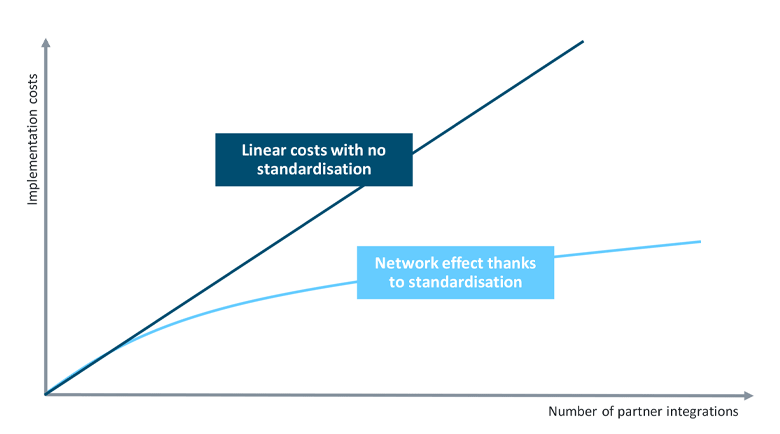API-led B2B Integration – Part 1: Why are Companies Using APIs in their B2B Integration?

APIs are used in every industry to simply and easily connect systems and applications. This increases the efficiency and flexibility of an IT landscape and promotes synergies. Each organisation can define and implement their own internal interfaces for an API, or adopt APIs from existing standard systems. API integration and management systems enable companies to manage their APIs centrally and efficiently.
It gets exciting when companies start using APIs to network their IT landscapes and business applications with each other.
In the first part of a three-part blog series on API-led B2B integration, SEEBURGER expert Thomas Kamper looks at why companies use APIs to integrate their partners, and what practical hurdles they may encounter in API-led B2B integration.
APIs for external integration
Companies have been using technology for decades to exchange documents and data. In the consumer goods and manufacturing industries, retail, banks and financial services , in the energy, , automotive and logistics industries, nearly every company uses technologies such as classic electronic data interchange (EDI) for digital networking. These have become established as robust technologies for exchanging large volumes of documents and data.
There is therefore no sign that APIs are likely to fully usurp EDI. There is also nothing by business analysts on the internet considering such a scenario. However, it is in the nature of things that there will be individual EDI processes (low transfer volume or the need for speed), which could be better solved by using APIs.
Companies adopting API-led B2B integration have mostly been attracted by the time and costs savings these can offer, while also speeding up the transactions with their partners. APIs offer particular value in synchronous, fine-grain transfers, as shown in the image below:

Integrating your business partners with APIs has the following advantages:
- Speedier processes through
- synchronous communication
- real time transactions for fine-grain and high-frequency business needs
- a direct link between respective business systems
- Cost and time savings due to
- a fully-automated exchange of structured business data and documents (digitalise and automate)
- efficient business transactions based on current, consistent data
- eliminating the middleman in the VAN in business data exchange (a VAN is a value added network, often still used in classic B2B integration processes. This increases costs.)
APIs alone don’t guarantee an efficient B2B integration
Some companies make their internal APIs publicly available, alongside the associated data and application services. They hope their business partners will use these, as in the famous saying “if we build it, they will come”. But hardly anybody comes. The work in implementing these APIs is usually too high for the business partners.
Another approach is to set up bilateral APIs on a case-by-case basis. However, this usually ends up being just as frustrating for both companies. They have both invested a lot of effort and time in their equally individual APIs. Naturally, each partner wants to use its own, existing Rest-APIs or SOAP interfaces to communicate with their external partners. Unfortunately, the other partner would have to put a lot of work in before they can start communicating with each other.
And with each new partner, it all starts again.
What could drive forward API-led B2B integration?
There are three scenarios which can push the use of APIs in B2B integration:
- There is an industry standard that covers the needs and requirements of the intended B2B process and typical business transactions.
Transactions differ greatly from industry to industry. Therefore, any standard must cover the specific needs of the industry. This is likely to lead to general acceptance within the industry, making new business partners also willing to adopt it. Once a company has implemented the standard, they only need to configure and test integrations with further partners. In fact, an integration platform with API management and integration functionality will do this for you; cleanly, efficiently, and in line with the necessary security requirements.
The more companies follow and adopt the industry standard, the more sustainable the network effect.

- Data networks and transaction platforms have become established in an industry. They are extremely important for many companies in this and related industries.
Integrating your systems with these hubs leads to a competitive advantage. Conversely, not doing so quickly becomes a handicap.
- One particular company is dominant within the industry’s value chain and enough other companies need to do business with it.
That economic dependency is enough of a reason for a business partner to implement the dominant company’s specifications.
The network effect is irrelevant in the latter two scenarios. Instead, the use of APIs arise from changes within the industry which companies need to comply with. These may be from within, from outside, or economic. However, using an integration platform, or an API integration and management service is key here, too. It ensures that the B2B integration work remains within a justifiable and calculable framework, and also eliminates security risks.
How about using the APIs in prominent business applications like SAP, Microsoft or Salesforce, instead? Would that be a good alternative?
No, it wouldn’t. Each of those companies have developed a specific data model, which is used for integrating their APIs. There’s Microsoft‘s Common Data Model, SAP’s One Domain Model and yet another data model from Salesforce. Two partners wanting to communicate with one another may not have the same provider. This would mean a lot of integration work for at least one of the partners.
There will certainly be individual cases where two partners who use the same business application may agree to use its API functionality to communicate with each other. It has been known for SAP users to pragmatically resort to using iDoc to communicate between organisations. Nevertheless, the IDoc has not become an established standard.
However, the above is simply not enough to get the network effect an industry needs to further its digitalisation. Not only do the systems and applications used in the industry come from different providers, there are also legacy systems and in-house creations.
Indeed, if we look at how EDI messaging standards and technologies have been adopted over the decades, we can see that it wouldn’t have been possible without the introduction of industry standards.
Which industries are adopting API-led B2B integration?
Part two of the blog series considers this question, and answers it based on our experience with hundreds of clients and users from a variety of industries. Have a look at: API-led B2B Integration – Part 2: Which Industries are Adopting API-led B2B Integration?
Thank you for your message
We appreciate your interest in SEEBURGER
Get in contact with us:
Please enter details about your project in the message section so we can direct your inquiry to the right consultant.
Written by: Thomas Kamper
Thomas Kamper, SVP Strategic Product Management, is responsible for strategic product initiatives related to all SEEBURGER’s business integration technology and solutions. The focus is currently on API solutions and Big Data. In addition, he is responsible for solutions that enable organizations to master challenges of visibility and to control the proper execution of digitalized business processes. Thomas rejoined SEEBURGER December 2017. Before, he worked for many years as a hands-on interim manager and business advisor supporting C-level executives within software and cloud service providers to make their strategic product initiatives successful.





